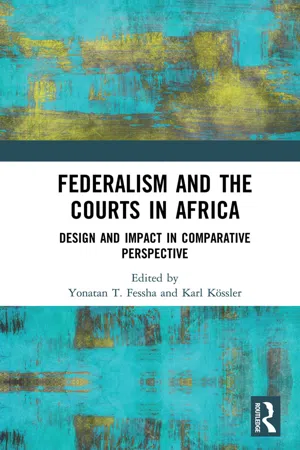
Federalism and the Courts in Africa
Design and Impact in Comparative Perspective
Yonatan T. Fessha, Karl Kössler, Yonatan T. Fessha, Karl Kössler
- 168 pages
- English
- ePUB (mobile friendly)
- Available on iOS & Android
Federalism and the Courts in Africa
Design and Impact in Comparative Perspective
Yonatan T. Fessha, Karl Kössler, Yonatan T. Fessha, Karl Kössler
About This Book
This volume examines the design and impact of courts in African federal systems from a comparative perspective.
Recent developments indicate that the previously stymied idea of federalism is now being revived in the constitutional arrangements of several African countries. A number of them jumped on the bandwagon of federalism in the early 1990s because it came to be seen as a means to facilitate development, to counter the concentration of power in a single governmental actor and to manage communal tensions. An important part of the move towards federalism is the establishment of courts that are empowered to umpire intergovernmental disputes. This edited volume brings together contributions that first discuss questions of design by focusing, in particular, on the organization of the judiciary and the appointment of judges in African federal systems. They then examine whether courts have had a rather centralizing or decentralizing impact on the operation of African federal systems.
The book will be of interest to researchers and policy-makers in the areas of comparative constitutional law and comparative politics.
Frequently asked questions
1
Judicial federalism in comparative perspective
1. Introduction
2. Apex courts
2.1 Design
Table of contents
- Cover
- Half Title
- Title Page
- Copyright Page
- Contents
- Table of cases
- Notes on editors and contributors
- Acknowledgments
- Introduction
- 1 Judicial federalism in comparative perspective
- 2 Federalism and the courts in Nigeria
- 3 Giving ‘shape and texture’ to a federal system? Ethiopia’s courts and its unusual umpire
- 4 The courts and the provinces in South Africa
- 5 The courts and local governments in South Africa
- 6 The courts and devolution: the Kenyan experience
- Comparative observations
- Index